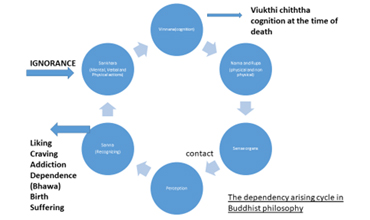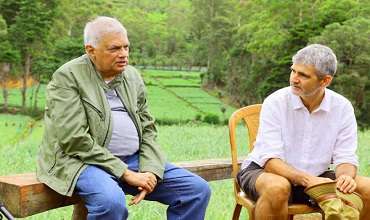The cycle of Dependency Arising - a scientific formula for higher brain and mind functioning
The cycle of Dependency Arising (paticca samuppāda) - a scientific formula for higher brain and mind functioning
By Dr D.P.D. Wijesinghe
Buddhism is a scientific philosophy rather than a traditional religion. The core element in Buddhist philosophy is understanding based on analysis of cause and effect. These are very evident in some of sutras like Kalama, Chullahasthi padopama and Chanki sutra. These sutras describe the Buddhist way of thinking based on free and independent analysis, not going to conclusions without adequate evidence and acceptance not by belief but by direct understanding.
Living in a technologically advanced world based on scientific thinking, scientists have investigated the human nervous system comprehensively. The ultimate goal of Buddhism is also to understand the true nature of mind and matter.
Modern neuroscience has described many functions of the nervous system including perception, information processing, memory, liking(motivation), craving and to some extent thinking. Scientists have described the neuro- electrical and neuro-chemical basis for functions in the brain. These discoveries include developmental, anatomical and electro-chemical functions of synapse, a bridge like important structure between two neuronal cells. But still there is a vacuum of knowledge about understanding the feeling of self–perception and other higher levels of thinking.
The Buddhism describes six organs imperative for our perceptions. These six organs include eye, nose, ear, tongue, skin and manasa (a part of the brain). The first five of these are compatible with the neuroscientific categorization of sense organs. But in Buddhism, manasa (compatible with a part of the brain) is also classified as a sense organ as it senses and perceives thoughts, emotions, flashbacks and memories. Like the other five sense organs, the manasa is also a rupa (physical) structure. In other word, all of these six organs are biological. The biological basis of thoughts, emotions, flashbacks and memories through neurotransmitters and synapse are well described in neuroscience today.
The cycle of Dependency arising (paticca samuppāda)
The Lord Buddha has described a cyclic cascade of phenomenological and conditional reactions to describe the perception beyond the level of contact with sense organ. This cycle of cascade of reactions is known as Dependency arising or paticca samuppāda in Buddhist texts.
A discussion about Dependency arising is important due to two reasons in today’s context. First, it provides some light into the vacuum of knowledge in neuroscience about higher brain functions. Then it is necessary for a Buddhist to understand it in order to attain Nibbana.
This cycle starts with rupa (physical, biological) component where there is a physical contact of a sense organ with light, smell, touch, sound, taste, thoughts, emotions, memories and flashbacks. Six sense organs are described in Buddhist sutra which include eye, ear, skin, olfactory system, tongue and manasa. Neurological science describes five sense organs excluding the part of brain. The meaning of sense organ is an organ responsible to gather information. According to classification in Dependency arising manasa is the sense organ responsible to gather internal information like thoughts, emotions, memories and flashbacks. The sixth sense organ described as Manasa is very compatible with a part of the brain involved in higher functions.
Some scholars have incompletely described sense organs when they discuss about the role of sense organs in Dependency arising. For example, the anatomical part of eye is discussed up to the level of eye ball and retina. It should include the optic nerve, its pathway and part of cerebral cortex involved in visual functions. Therefore, the sense organ eye means visual system rather than the eyeball only. The same is applied to other sense organs like ear, skin, olfactory and tongue. These five sensory organs should be understood as visual, auditory, olfactory, sensory and taste systems. The manasa part is more complex, probably involving frontal cortex and limbic system in the brain. The Lord Buddha has himself advised Ananda Thero not to take the Dependency arising as simple; it is very complex.
The above mentioned physical contact results in the phenomena of perception. The next component after perception is analyzing and recognizing(saññā). The meaning of saññā is recognizing after analyzing according to available knowledge and information. The next step is verbal, physical or mental actions. These actions are termed in this cascade as sañkhāra.
Physical, verbal or mental actions (sañkhāra) make the relevant cognition known as viññāna. The cognition (viññāna) described here has both physical (rupa) and non-physical (nama) properties. The madhupindika sutra describes about mental proliferations (prapñca) happening at the time of formation of viññāna. Six types of cognitions are described according to sense organs mentioned before. There are sub components of cognitions to each type. Some scholars have used consciousness to described viññāna. It is not correct to use the word ‘consciousness’ for viññāna because consciousness is technically defined as awareness about self and surroundings. The continuation of this cognition (viññāna) is necessary to continued functioning of sense organs.
The perception when a sense organ has contact with such physical sensation, makes liking, addiction and cravings. The craving results in dependence on samsara (bhawaya). Dependence on samsara will result in re-incarnation, birth and universal suffering. The dependency arising will continue as a cycle as sense organs contact with sensations.
Three main areas of ignorance about nature make the person to make ignorant sañkhāra which take the person through these endless cycles. These three give energy to this cyclic cascade of dependency arising to continue as a vicious cycle making the person to undergo endless samsaric sufferings.
- Ignorance that there is self-soul
- Ignorance that matter, perception, actions, cognition and physical and psychological things are permanent
- Ignorance that samsara repetition is pleased
Ceasation of above ignorance by comprehensively understanding the true realistic nature of the samsara is the prescribed way to end this cycle of universal suffering.

Dependence arising described by Lord Buddha is very interesting and imperative. We should look at it as a scientific researcher in the way described in Kalama, Chullahasthi padopama and Chanki sutras.
Firstly, it gives some light to understand and investigate further about neuropsychological events of higher brain functions after perception. The current knowledge about higher functions are limited up to the level of biological events of neurotransmission, synaptic adaptation (apoptosis) and events like post-tetanic potentiation in synapse. The Dalai Lama conducted several conferences with world famous neurologists and stressed the importance of studying knowledge about higher mind functions in Buddhist philosophy.
The understanding of Dependency arising is essential to a Buddhist who want to reach the final goal of attaining Nibbbana. The Lord Buddha has prescribed the Noble Eight-fold Pathway to disciples who wishes to end universal suffering. Practising mindfulness is only one of this pathway and it is scientifically proven that mindfulness improves both brain and psychological functions. The most important is the elimination of ignorance which causes re-continuation of dependency arising cyclic cascade leading to universal suffering. Self-cultivation of the Vidharsana knowledge is the only way to eliminate ignorance. The only way to cultivate Vidharsana knowledge is through Vidharsana meditation.
In addition to explaining momentary continuation, the cascade of dependency arising also explains the mechanism of re-incarnation as described in Buddhist philosophy. As already described in this article, perception makes likeness, addiction, craving and dependence on samsara (bhawaya). The dependency on samsara make birth and further sufferings. A part of cognition, known as viuthi chiththa is released and incarnated as prathisandi chiththa in another suitable destination at the time of death due to the dependency. The process of incarnation is not a rebirth of same, but continuation from the previous conditionings. It appears that the mechanism involved here is somewhat similar to the quantum mechanism and there is no travel in between. The first thought in new fetus is known as bawanga chiththa and gives a base for future thoughts.
Where is the mind? it is an unanswered question. Some scholars have equalled mind to cognition. It is not correct to equal mind to cognition. The mind and products of mind are described in Buddhism as chiththa (mind) and chithasika (thoughts). Thoughts occur at the levels of saññā, cognition, liking and craving in the cascade of dependency arising. Some scholars argue that there is no mind. They may have many arguments; but that thought is again coming through their minds and brains. For the purpose of understanding, we can compare our brain and mind to a most advanced computer. The computer may have things parallel to saññā but never goes beyond that. The artificial intelligence is again a type of saññā but not a viññāna.
-
Still No Comments Posted.













Leave Comments